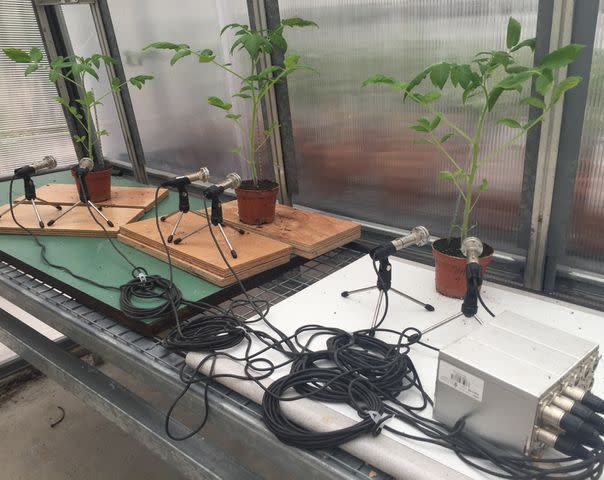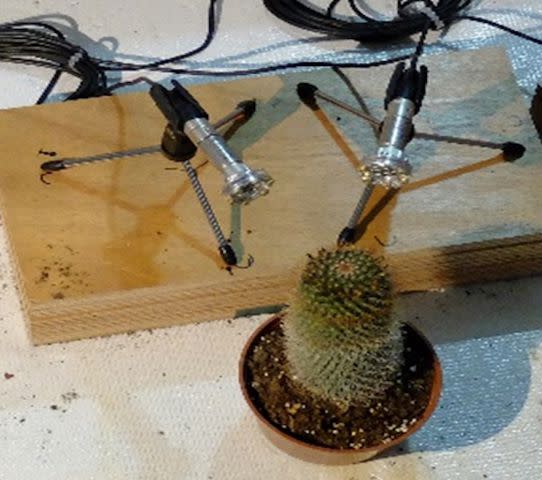Stressed Plants Make Sounds, We Just Can't Hear Them
Say what? Plants emit high-frequency sounds comparable in volume to normal human conversation.

Imagine if your houseplant was thirsty, and it could tell you so. Chances are, it can—you just can't hear it. At least according to findings from researchers in Israel, who discovered that tomato and tobacco plants stressed from dehydration or having their stems cut emit sounds comparable in volume to normal human conversation.
The sound is kind of a snap, crackle, and pop—though more like bubble wrap than Rice Crispies. Or like someone slowly typing on a manual typewriter. And while the frequency of the plant yelps is too high for our ears, they can likely be heard by insects, other mammals, and possibly other plants. (The recording, which you can listen to here, has its frequency lowered so that it's audible to human ears.)
"Even in a quiet field, there are actually sounds that we don't hear, and those sounds carry information," says senior author Lilach Hadany, an evolutionary biologist and theoretician at Tel Aviv University. "There are animals that can hear these sounds, so there is the possibility that a lot of acoustic interaction is occurring."

Ohad Lewin-Epstein
Three tomato plants whose sounds are being recorded in a greenhouseWhile the team notes that ultrasonic vibrations from plants have been recorded previously, this is the first evidence that they are airborne, making them more relevant for other organisms around them. “Plants interact with insects and other animals all the time, and many of these organisms use sound for communication, so it would be very suboptimal for plants to not use sound at all,” says Hadany.
Related:Trees Talk to Each Other and Recognize Their Offspring
The team started with both healthy and stressed tomato and tobacco plants—the stressed ones were either unwatered for several days or had their stems cut. They recorded the group first in a soundproofed acoustic chamber and then in a noisier greenhouse. They also trained a machine-learning algorithm to differentiate between happy plants, thirsty plants, and cut plants.
The team found that stressed plants emit more sounds than unstressed plants, with a stressed plant emitting 30 to 50 clicks per hour at seemingly random intervals. Unstressed plants were much less active. "When tomatoes are not stressed at all, they are very quiet," says Hadany.
"Water-stressed plants began emitting noises before they were visibly dehydrated, and the frequency of sounds peaked after five days with no water before decreasing again as the plants dried up completely. The types of sound emitted differed with the cause of stress," according to a press release for the research. "The machine-learning algorithm was able to accurately differentiate between dehydration and stress from cutting and could also discern whether the sounds came from a tomato or tobacco plant."
The researchers explain that it's unclear whether or not the sounds result from an effort to communicate—yet they note that the sounds have significant ecological and evolutionary implications. "It's possible that other organisms could have evolved to hear and respond to these sounds," says Hadany. "For example, a moth that intends to lay eggs on a plant or an animal that intends to eat a plant could use the sounds to help guide their decision."
It is also possible that other plants are eavesdropping. Several of the researchers previously found that plants boost the sugar levels in their nectar when they "hear" nearby pollinators. Meanwhile, other research has revealed that plants change their gene expression in response to sounds.
"If other plants have information about stress before it actually occurs, they could prepare," says Hadany.
"So now that we know that plants do emit sounds, the next question is—'who might be listening?'" says Hadany. "We are currently investigating the responses of other organisms, both animals and plants, to these sounds, and we're also exploring our ability to identify and interpret the sounds in completely natural environments."

Itzhak Khait
A cactus being recordedAnd just because the research focused on tomatoes and tobacco plants doesn't mean your monstera and pathos are necessarily keeping mum. The team also recorded a variety of other plant species, and the whole lot of them had things to say, or at least clicks to make. As Hadany says, “We found that many plants—corn, wheat, grape, and cactus plants, for example—emit sounds when they are stressed."
The study, "Sounds emitted by plants under stress are airborne and informative," was published in the journal Cell.

